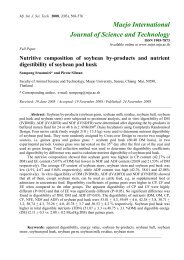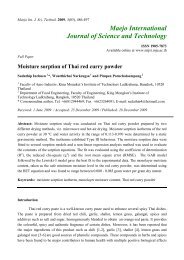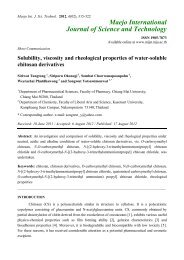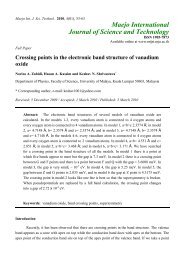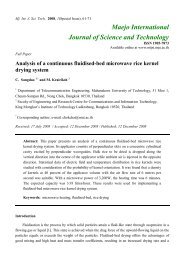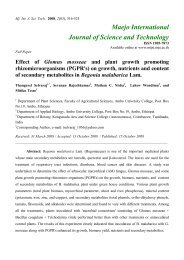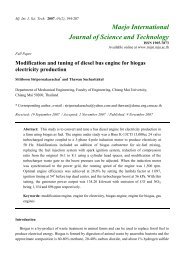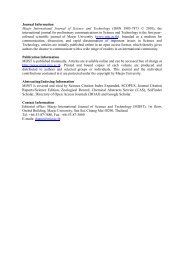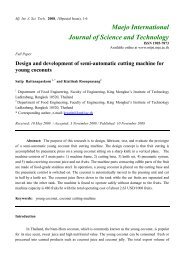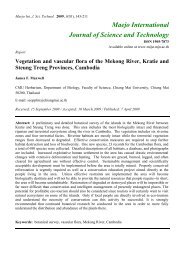Phenolic content and antioxidant properties of green chilli - Maejo ...
Phenolic content and antioxidant properties of green chilli - Maejo ...
Phenolic content and antioxidant properties of green chilli - Maejo ...
Create successful ePaper yourself
Turn your PDF publications into a flip-book with our unique Google optimized e-Paper software.
<strong>Maejo</strong> Int. J. Sci. Technol. 2010, 4(02), 193-200Communication<strong>Maejo</strong> InternationalJournal <strong>of</strong> Science <strong>and</strong> TechnologyISSN 1905-7873Available online at www.mijst.mju.ac.th<strong>Phenolic</strong> <strong>content</strong> <strong>and</strong> <strong>antioxidant</strong> <strong>properties</strong> <strong>of</strong> <strong>green</strong> <strong>chilli</strong> paste<strong>and</strong> its ingredientsKamonrat Ruanma, Lalida Shank <strong>and</strong> Griangsak Chairote*Department <strong>of</strong> Chemistry <strong>and</strong> Centre for Innovation in Chemistry, Faculty <strong>of</strong> Science,Chiang Mai University, Chiang Mai 50200, Thail<strong>and</strong>* Corresponding author, e-mail: griangsa@chiangmai.ac.thReceived: 27 January 2009 / Accepted: 15 May 2010 / Published: 19 May 2010Abstract: Green <strong>chilli</strong> paste <strong>and</strong> its ingredients (<strong>chilli</strong>, red onion <strong>and</strong> garlic) from differentstages <strong>of</strong> processing were analysed for total phenolic <strong>content</strong> <strong>and</strong> <strong>antioxidant</strong> <strong>properties</strong>, i.e.total <strong>antioxidant</strong> capacity, DPPH radical scavenging activity, <strong>and</strong> β-carotene bleaching activity.The effects <strong>of</strong> processing stage on total phenolic <strong>content</strong> <strong>and</strong> <strong>antioxidant</strong> <strong>properties</strong> <strong>of</strong> <strong>green</strong><strong>chilli</strong> paste <strong>and</strong> its ingredients were discussed, along with the correlation between the totalphenolic <strong>content</strong> <strong>and</strong> the <strong>antioxidant</strong> <strong>properties</strong>.Keywords: <strong>green</strong> <strong>chilli</strong> paste, total phenolic <strong>content</strong>, <strong>antioxidant</strong> <strong>properties</strong>IntroductionAn <strong>antioxidant</strong> refers to any substance which, when present at low concentration compared tothat <strong>of</strong> an oxidisable substrate, significantly delays or prevents oxidation <strong>of</strong> that substrate. Antioxidantsare divided into two groups: natural enzymatic <strong>antioxidant</strong>s <strong>and</strong> non-enzymatic ones. The naturalenzymatic <strong>antioxidant</strong>s, e.g. superoxide dismutases, catalases <strong>and</strong> enzymes, are located mostly inperoxisomes. Natural <strong>and</strong> synthetic non-enzymatic <strong>antioxidant</strong>s consist <strong>of</strong> vitamin E <strong>and</strong> related<strong>antioxidant</strong>s such as vitamin C, BHT, BHA, carotenoids, glutathione <strong>and</strong> derivatives, phenoliccompounds, flavonoids <strong>and</strong> alkaloids [1-2]. Foods or food materials are an important source <strong>of</strong><strong>antioxidant</strong> compounds for human consumption. Natural <strong>antioxidant</strong>s present in the diet increase theresistance to oxidative damage. Fruits <strong>and</strong> vegetables are immensely valuable not only for theirnutritional value but also for their potential health functionality against various degenerative diseases[3-4].
<strong>Maejo</strong> Int. J. Sci. Technol. 2010, 4(02), 193-200195Total phenolic <strong>content</strong>The total phenolic <strong>content</strong> was measured spectrophotometrically following the procedureoutlined by Siddhuraju [15]. The reaction mixture contained 50% Folin-Ciocalteu reagent (0.5 ml),20% (w/v) sodium carbonate solution (2.5 ml), <strong>and</strong> gallic acid solution or sample extract (1.0 ml). Themixture was placed in the dark for 40 minutes <strong>and</strong> the absorbance was recorded at 750 nm against ablank with a spectrometer (Perkin-Elmer: Lamda 25 UV/VIS).Preparation <strong>of</strong> the calibration curve for total phenolic <strong>content</strong> determination was carried outusing gallic acid (2-10 g/ml). The total phenolic <strong>content</strong> was expressed based on gallic acidequivalent (GAE).Determination <strong>of</strong> total <strong>antioxidant</strong> capacityThe assay is based on the reduction <strong>of</strong> Mo(VI) to Mo(V) by the extract <strong>and</strong> subsequentformation <strong>of</strong> a <strong>green</strong> phosphate/Mo(V) complex at acidic pH. The procedure set out by Banergee et al.[16] was followed. St<strong>and</strong>ard gallic acid solution or the extract (1 ml) was combined with 3.0 ml <strong>of</strong> thereagent solution containing 0.6 M sulphuric acid, 28 mM sodium phosphate <strong>and</strong> 4 mM ammoniummolybdate. The mixture was incubated at 95 o C for 90 minutes. After cooling to room temperature, theabsorbance <strong>of</strong> the solution was measured at 725 nm.Preparation <strong>of</strong> the calibration curve for total <strong>antioxidant</strong> capacity was carried out using gallicacid (2.5-10 g/ml). The total <strong>antioxidant</strong> capacity was expressed based on GAE.DPPH radical scavenging activityFree radical scavenging activity was determined using the stable 1,1-diphenyl-2-picrylhydrazyl(DPPH) free radical. The extract (1 ml) was added to 3.0 ml <strong>of</strong> 0.004% methanolic solution <strong>of</strong> DPPH.After 30 minutes the absorbance (A) at 517 nm was measured. The per cent inhibition was calculatedas [1 – A extract /A blank ] x 100. The relationship between per cent inhibition <strong>and</strong> sample concentrationwas plotted to determine the IC 50 value [16].-Carotene bleaching activityThe determination <strong>of</strong> the <strong>antioxidant</strong> activity as the ability to delay the bleaching <strong>of</strong> -carotenein a water/linoleic acid emulsion was performed according to Nsimba et al [17]. To prepare the -carotene emulsion, 0.2 ml <strong>of</strong> -carotene solution (0.2 mg/ml in chlor<strong>of</strong>orm) was transferred to a roundbottomflask containing linoleic acid (20 l) <strong>and</strong> Tween 20 (200 l). The mixture was evaporated at40 o C for 10 minutes to remove the solvent <strong>and</strong> distilled water (100 ml) was immediately added. The -carotene emulsion (5.0 ml) was transferred to a test tube containing the test sample (0.2 ml). Themixture was shaken <strong>and</strong> placed in a water bath at 50 o C for 2 hours before its absorbance was measuredat 470 nm.The percent inhibition was calculated as [1 – (A 0 – A t )/ (A 0 0 - A t 0)] x 100), where A 0 <strong>and</strong> A 0 0are the absorbance values measured at initial time <strong>of</strong> the incubation for sample <strong>and</strong> controlrespectively, <strong>and</strong> A t <strong>and</strong> A t 0 are the absorbance values <strong>of</strong> sample <strong>and</strong> control respectively at t minutes.The relation between per cent inhibition <strong>of</strong> -carotene oxidation <strong>and</strong> sample concentration was plottedto determine the IC 50 value.
<strong>Maejo</strong> Int. J. Sci. Technol. 2010, 4(02), 193-200196Results <strong>and</strong> DiscussionTotal phenolic <strong>content</strong>Thermal processing can cause both positive <strong>and</strong> negative changes in total phenolic <strong>content</strong> <strong>of</strong>GCP <strong>and</strong> its ingredients as shown in Table 1. Heat-processed <strong>chilli</strong> <strong>and</strong> garlic have slightly lowerphenolic <strong>content</strong> than their fresh counterparts while heat-processed onion has an increase <strong>of</strong> totalphenolic <strong>content</strong>. On the one h<strong>and</strong>, high temperature involved in the processing might have assisted inthe decomposition <strong>of</strong> complex phenolic compounds thus releasing the free phenolics leading to anincrease in total phenolic <strong>content</strong> [8, 18]. On the other h<strong>and</strong>, many other studies have shown thatheating process has both negative <strong>and</strong> positive effects on total phenolic <strong>content</strong> <strong>of</strong> plant materialsincluding fruits <strong>and</strong> vegetables, depending on the type <strong>of</strong> raw materials <strong>and</strong> the groups <strong>of</strong> compoundspresent [13-14, 18-21]. Li et al. [22] reported that heat treatment caused a reduction in total phenolic<strong>content</strong> during the processing <strong>of</strong> purple wheat bran. Zhang <strong>and</strong> Hamauzu [13] also reported that<strong>antioxidant</strong> components in broccoli are significantly lost during cooking.From Table 1, the total phenolic <strong>content</strong> in degassed GCP, which has also been subjected toheat treatment, is not lowered compared to that in unprocessed GCP. Apparently, oxygen removalreduces the oxidation process <strong>and</strong> inactivates enzymatic reactions in GCP. Oms-Oliu et al. [12] havealso found that a low oxygen level is ideal for maintaining vitamin C <strong>and</strong> phenolic <strong>content</strong> duringstorage.As in the case <strong>of</strong> onion, the total phenolic <strong>content</strong> in sterilised GCP is significantly higher thanuntreated GCP, which is also probably due to the same reason, i.e. the release <strong>of</strong> free phenoliccompounds from some more complex molecules upon sterilisation.Table 1. Total phenolic <strong>content</strong> <strong>and</strong> total <strong>antioxidant</strong> capacity <strong>of</strong> GCP <strong>and</strong> its ingradientsSampleTotal phenolic<strong>content</strong>(mg GAE/mg DPM)Total <strong>antioxidant</strong>capacity(mg GAE/mg DPM)Chilli Fresh 3.42+0.08 14.91+0.75Heat-processed 2.69+0.02 14.22+0.60Red onion Fresh 10.59+0.34 10.98+0.60Heat-processed 12.82+0.46 11.44+0.30Garlic Fresh 2.00+0.13 6.65+0.89Heat-processed 1.82+0.07 7.14+0.36Unprocessed GCP 5.93+0.26 18.22+0.49Degassed GCP 5.97+0.38 24.89+0.64Sterilised GCP 7.88+0.38 18.78+0.55Note: GAE = gallic acid equivalent; DPM = dry plant material;Results are reported with + SD.
<strong>Maejo</strong> Int. J. Sci. Technol. 2010, 4(02), 193-200197Antioxidant <strong>properties</strong>The <strong>antioxidant</strong> <strong>properties</strong> were investigated using in vitro methods. The total <strong>antioxidant</strong>capacity is shown in Table 1. Fresh <strong>and</strong> heat-processed <strong>chilli</strong> apparently has a higher level <strong>of</strong> total<strong>antioxidant</strong> capacity than that <strong>of</strong> red onion or garlic. An earlier study also reported that <strong>chilli</strong> has astrong <strong>antioxidant</strong> activity [21]. Banerjee et al. [16] reported that the phenolics <strong>of</strong> <strong>green</strong> pepper (Pipernigrum L.) has higher DPPH radical scavenging capacity than the acetone extract <strong>of</strong> nutmeg mace(Myristica fragrans).Heat processing is observed in this study to have pronounced effects on the three ingredients <strong>of</strong>GCP. In addition, removal <strong>of</strong> <strong>chilli</strong> skin prior to heat processing may result in the loss <strong>of</strong> someimportant compounds in <strong>chilli</strong> such as vitamin C, tocopherol, -carotene <strong>and</strong> alkaloids, withconsequent reduction <strong>of</strong> <strong>antioxidant</strong> activities <strong>of</strong> heat-processed <strong>chilli</strong> compared to the fresh one.However, they are enhanced in heat-processed red onion <strong>and</strong> garlic (Tables 1-2). In this case, it is mostprobable that heat processing has released such compounds as free aglycones or Maillard products thatcan reduce Mo(VI) to Mo(V) <strong>and</strong> also react as an electron donor or transfer a hydrogen atom to theDPPH radical, thus increasing the <strong>antioxidant</strong> <strong>properties</strong>.From Tables 1-2, the <strong>antioxidant</strong> capacity <strong>and</strong> DPPH radical scavenging activity <strong>of</strong> both types<strong>of</strong> processed GCP apparently increase compared to unprocessed GCP. Earlier studies showed thatsterilisation causes changes in the texture, colour <strong>and</strong> flavour <strong>of</strong> GCP [8, 23]. Sterilisation alsoproduces a bitter taste in GCP. The main bitter compounds, identified as catechins, were shown toincrease upon sterilisation [8]. This result supports the hypothesis that sterilisation releases somephenolic compounds <strong>and</strong> these products increase the <strong>antioxidant</strong> <strong>properties</strong>. R<strong>and</strong>hir et al. [18] foundthat thermal processing <strong>of</strong> sprouts <strong>and</strong> seedlings <strong>of</strong> wheat, buckwheat, corn <strong>and</strong> oat causes changes intheir health-relevant functionality <strong>and</strong> suggested that these changes are due to modifications in the totalphenolic <strong>content</strong> leading to a higher <strong>content</strong> with consequent increase in scavenging-linked <strong>antioxidant</strong>activity. However, the <strong>antioxidant</strong> capacity <strong>of</strong> sterilised GCP is seen to be lower than that <strong>of</strong> degassedGCP, which may be accounted for by the postulate that certain compounds with reducing propertymight have been adversely affected by the sterilisation process.In attempting to correlate the total phenolic <strong>content</strong> with <strong>antioxidant</strong> <strong>properties</strong>, one can seethat the correlation is rather poor. Among the three ingredients, fresh <strong>and</strong> heat-processed <strong>chilli</strong> issecond in total phenolic <strong>content</strong>, yet it is strongest in both <strong>antioxidant</strong> <strong>properties</strong>. Red onion has thehighest total phenolic <strong>content</strong> although it shows only medium levels in both <strong>antioxidant</strong> <strong>properties</strong>(Tables 1-2). In this regard, it is clear that the <strong>antioxidant</strong> <strong>properties</strong> may not only come from aphenolic group [6]; substances such as capsaicin <strong>and</strong> sulfur compounds may also be associated withthe <strong>antioxidant</strong> <strong>properties</strong> <strong>of</strong> <strong>chilli</strong> <strong>and</strong> garlic [24]. Conversely, it is well known that not every phenolicsubstance is a good <strong>antioxidant</strong>. This may be evident from a result in Table 1, in which sterilised GCP,though highest in total phenolic <strong>content</strong> among the three GCPs, is not highest in total <strong>antioxidant</strong>capacity.The -carotene bleaching method is based on the loss <strong>of</strong> the yellow colour <strong>of</strong> -carotene due toits reaction with radicals formed by linoleic acid oxidation in an emulsion. The rate <strong>of</strong> -carotenebleaching can be slowed down in the presence <strong>of</strong> an <strong>antioxidant</strong>. However, it can be seen in thisexperiment that the different processing steps did not seem to affect the <strong>antioxidant</strong> property <strong>of</strong> GCP as
<strong>Maejo</strong> Int. J. Sci. Technol. 2010, 4(02), 193-200198determined by the -carotene bleaching method. The IC 50 remains relatively constant as shown inTable 2. Conforti et al. [25] reported that a high level <strong>of</strong> phenolic <strong>content</strong> <strong>and</strong> an acyclic diterpenealcohol (phytol) in <strong>green</strong> pepper fruit are responsible for the inhibition <strong>of</strong> lipid peroxidation, althoughthis effect takes place only at the ripening stage <strong>of</strong> the fruit. Furthermore, although the correlationbetween total phenolic <strong>content</strong> <strong>and</strong> <strong>antioxidant</strong> activity by the DPPH test was found for small <strong>green</strong><strong>and</strong> red pepper extracts, no correlation was found for -carotene bleaching test <strong>and</strong> bovine brainperoxidation assay.Table 2. DPPH radical scavenging <strong>and</strong> β-carotene bleaching activities<strong>of</strong> GCP <strong>and</strong> its ingredientsSampleDPPH methodIC 50 (mg/ml)β-Carotene methodChilli Fresh 2.12+0.02 -Heat-processed 2.33+0.11 -Red onion Fresh 4.00+0.34 -Heat-processed 3.75+0.28 -Garlic Fresh 19.83+0.77 -Heat-processed 17.63+0.93 -Unprocessed GCP 3.48+0.15 1.02+0.02Degassed GCP 3.07+0.12 1.10+0.05Sterilised GCP 2.67+0.08 1.07+0.03St<strong>and</strong>ard BHT 8.31+0.18* 0.54+0.01*quercetin 0.31+0.01* 4.37+0.06*Note: - = Not investigated; * = in g/ml;Results are reported with + SD.ConclusionsThe total phenolic <strong>content</strong> <strong>and</strong> <strong>antioxidant</strong> <strong>properties</strong> <strong>of</strong> <strong>green</strong> <strong>chilli</strong> paste <strong>and</strong> its ingredientsare observed to be affected on being processed. The overall effect <strong>of</strong> processing, though not apparentlyextensive or outst<strong>and</strong>ing, nevertheless seems to be somewhat beneficial to both <strong>of</strong> the <strong>green</strong> <strong>chilli</strong> pasteproducts (i.e. degassed <strong>and</strong> sterilised) compared to the unprocessed product.AcknowledgementsThe authors would like to express their sincere gratitude to the Centre for Innovation inChemistry: Postgraduate Education <strong>and</strong> Research Program in Chemistry (PERCH-CIC) <strong>of</strong> theCommission on Higher Education, Ministry <strong>of</strong> Education, for financial support. Chiang Mai VanusnunCo., Ltd. is thanked for supplying GCP <strong>and</strong> its ingredients for all the experiments. The Department <strong>of</strong>Chemistry, Faculty <strong>of</strong> Science, Chiang Mai University is acknowledged for supplying all <strong>of</strong> thechemicals <strong>and</strong> equipment needed in this work.
<strong>Maejo</strong> Int. J. Sci. Technol. 2010, 4(02), 193-200199References1. S. I. Baskin <strong>and</strong> H. Salem, “Oxidants, Antioxidants, <strong>and</strong> Free Radicals”, Taylor <strong>and</strong> Francis, NewYork, 1997.2. B. Halliwell, R. Aeschbach, J. Loliger <strong>and</strong> O. I. Aruoma, “The characterization <strong>of</strong> <strong>antioxidant</strong>s”,Food Chem., 1995, 33, 601-617.3. N. Deepa, C. Kaur, B. George, B. Singh <strong>and</strong> H. C. Kapoor, “Antioxidant constituents in some sweetpepper (Capsicum annuum L.) genotypes during maturity”, LWT-Food Sci. Technol., 2007, 40,121-129.4. B. Dimitrios, “Sources <strong>of</strong> natural phenolic <strong>antioxidant</strong>s”, Food Sci. Technol. Res., 2006, 17, 505-512.5. F. Ferreres, M. I. Gil <strong>and</strong> F. A. Tomas-Barberan, “Anthocyanins <strong>and</strong> flavonoids from shredded redonion <strong>and</strong> changes during storage in perforated films”, Food Res. Int., 1996, 29, 389-395.6. A. M. Nuutila, R. Puupponen-Pimia, M. Aarni <strong>and</strong> K. M. Oksman-Caldentey, “Comparison <strong>of</strong><strong>antioxidant</strong> activities <strong>of</strong> onion <strong>and</strong> garlic extracts by inhibition <strong>of</strong> lipid peroxidation <strong>and</strong> radicalscavenging activity”, Food Chem., 2003, 81, 485-493.7. K. S. Yoo <strong>and</strong> L. M. Pike, “Determination <strong>of</strong> flavor precursor compound S-alk(en)yl-L-cysteinesulfoxides by an HPLC method <strong>and</strong> their distribution in Allium species”, Sci. Hortic., 1998, 75, 1-10.8. K. Leelasakultum, “Study on bitter compounds in <strong>green</strong> <strong>chilli</strong> paste” (in Thai), Special Problem,2004, Department <strong>of</strong> Chemistry, Chiang Mai University, Thail<strong>and</strong>.9. M. Wayseangjarean, “Development <strong>of</strong> <strong>green</strong> <strong>chilli</strong> paste in bottle” (in Thai), Research Report,1999, Department <strong>of</strong> Agro Industry, Chiang Mai University, Thail<strong>and</strong>.10. G. N. Gayathri, K. Platel, J. Prakash <strong>and</strong> K. Srinivasan, “Influence <strong>of</strong> <strong>antioxidant</strong> spices on theretention <strong>of</strong> -carotene in vegetables during domestic cooking processes”, Food Chem., 2004, 84,35-43.11. L. Greco, R. Riccio, S. Bergero, A. A. M. Del Re <strong>and</strong> M. Trevisan, “Total reducing capacity <strong>of</strong>fresh sweet peppers <strong>and</strong> five different Italian pepper recipes”, Food Chem., 2007, 103, 1127-1133.12. G. Oms-Oliu, I. Odriozola-Serrano, R. Soliva-Fortuny <strong>and</strong> O. Martin-Belloso, “The role <strong>of</strong>peroxidase on the <strong>antioxidant</strong> potential <strong>of</strong> fresh-cut ‘Piel de Sapo’ melon packaged under differentmodified atmospheres”, Food Chem., 2008, 106, 1085-1092.13. D. Zhang <strong>and</strong> Y. Hamauzu, “<strong>Phenolic</strong>s, ascorbic acid, carotenoids <strong>and</strong> <strong>antioxidant</strong> activity <strong>of</strong>broccoli <strong>and</strong> their changes during conventional <strong>and</strong> microwave cooking”, Food Chem., 2004, 88,503-509.14. I. Odriozola-Serrano, R. Soliva-Fortuny <strong>and</strong> O. Martin-Belloso, “Changes <strong>of</strong> health-relatedcompounds throughout cold storage <strong>of</strong> tomato juice stabilized by thermal or high intensity pulsedelectric field treatments”, Innov. Food Sci. Emerg. Technol., 2007, 9, 272-279.15. P. Siddhuraju, “Antioxidant activity <strong>of</strong> polyphenolic compounds extracted from defatted raw <strong>and</strong>dry heated Tamarindus indica seed coat”, LWT-Food Sci. Technol., 2007, 40, 982-990.16. A. Banerjee, N. Dasgupta <strong>and</strong> B. De, “In vitro study <strong>of</strong> <strong>antioxidant</strong> activity <strong>of</strong> Syzygium cuminifruit”, Food Chem., 2005, 90, 727-733.
<strong>Maejo</strong> Int. J. Sci. Technol. 2010, 4(02), 193-20020017. R. Y. Nsimba, H. Kikuzaki <strong>and</strong> Y. Konishi, “Antioxidant activity <strong>of</strong> various extracts <strong>and</strong> fractions<strong>of</strong> Chenopodium quinoa <strong>and</strong> Amaranthus spp. seeds”, Food Chem., 2008, 106, 760-766.18. R. R<strong>and</strong>hir, Y. N. Kwon <strong>and</strong> K. Shetty, “Effect <strong>of</strong> thermal processing on phenolics, <strong>antioxidant</strong>activity <strong>and</strong> health-relevant functionality <strong>of</strong> select grain sprouts <strong>and</strong> seedlings”, Innov. Food Sci.Emerg. Technol., 2007, 9, 355-364.19. C. Ewald, S. Fjelkner-Modig, K. Johansson, I. Sjoholm <strong>and</strong> B. Akesson, “Effect <strong>of</strong> processing onmajor flavonoids in processed onions, <strong>green</strong> beans, <strong>and</strong> peas”, Food Chem., 1999, 64, 231-235.20. K. Lombard, E. Peffley, E. Ge<strong>of</strong>friau, L. Thompson <strong>and</strong> A. Herring, “Quercetin in onion (Alliumcepa L.) after heat-treatment simulating home preparation”, J. Food Compos. Anal., 2005, 18, 571-581.21. N. Turkmen, F. Sari <strong>and</strong> Y. S. Velioglu, “The effect <strong>of</strong> cooking methods on total phenolics <strong>and</strong><strong>antioxidant</strong> activity <strong>of</strong> selected <strong>green</strong> vegetables”, Food Chem., 2005, 93, 713-718.22. W. Li, M. D. Pickard <strong>and</strong> T. Beta, “Effect <strong>of</strong> thermal processing on <strong>antioxidant</strong> <strong>properties</strong> <strong>of</strong> purplewheat bran”, Food Chem., 2007, 104, 1080-1086.23. R. Pibunchaisit, “High pressure technique for improvement <strong>of</strong> shelf-life in <strong>green</strong> <strong>chilli</strong> paste” (inThai), Research Report, 2006, Department <strong>of</strong> Agro Industry, Chiang Mai University, Thail<strong>and</strong>.24. K. Kogure, S. Goto, M. Nishimura, M. Yasumoto, K. Abe, C. Ohiwa, H. Sassa, T. Kusumi <strong>and</strong> H.Terada, “Mechanism <strong>of</strong> potent antiperoxidative effect <strong>of</strong> capsaicin”, Biochim. Biophys. Acta, 2002,1573, 84-92.25. F. Conforti, G. A. Statti <strong>and</strong> F. Menichini, “Chemical <strong>and</strong> biological variability <strong>of</strong> hot pepper fruits(Capsicum annuum var. acuminatum L.) in relation to maturity stage”, Food Chem., 2007, 102,1096-1104.© 2010 by <strong>Maejo</strong> University, San Sai, Chiang Mai, 50290 Thail<strong>and</strong>. Reproduction is permitted fornoncommercial purposes.




